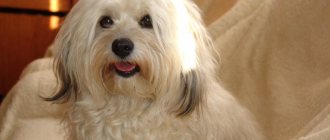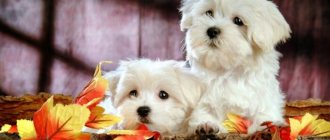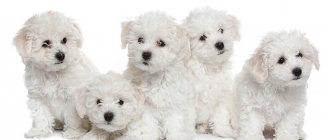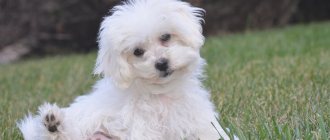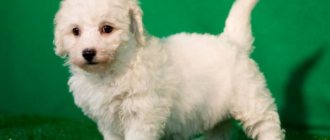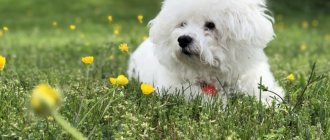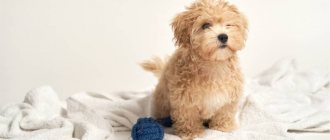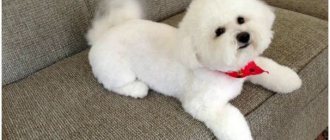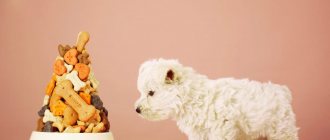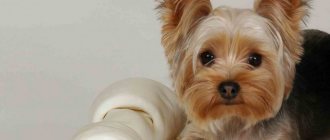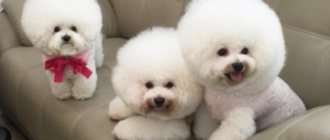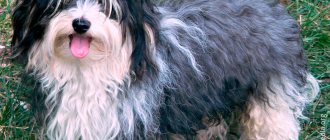Similar to plush toys, small dogs of the Bichon Frize breed are very popular: they are happily kept as companions, exhibitions are held for them, where the best representatives parade. The beloved Bichon Frize, whose photos adorn the albums, are full members of the family for all owners. These are amazingly kind and sweet dogs that respond with love to care for them.
Description
The Bichon Frize or Curly-haired dog breed is an excellent choice for families with children. Dogs are active, interesting and full of energy. Looking at these cute fur balls, you will fall in love with them from the first minute! In addition, animals have many qualities, including sociability, excellent watchdog skills, and the ability to get along well with other dogs and people.
Key facts
Loyalty, affectionateness, playfulness, mischief - these are the characteristics of the Bichon Frize breed. Reviews from the owners of French lap dogs speak about one thing: these mischievous little balls of fur win the hearts of people and make people smile with their touching seriousness. Photos, pictures, videos cannot convey the charm of these dogs.
The Bichon Frize is a companion dog, a little mischievous, smart, completely silent, and has the indescribable charm of a walking cloud. Responds to sonorous calls. She loves children, active walks and everyone's attention to her person. Occasionally, a dog may express indignation with a menacing growl or a demonstrative refusal to eat. It is easy to train, but due to its character it can be undisciplined.
The dog practically does not shed, but the dense undercoat and white hair twisted into tight spirals requires careful grooming and daily combing. The description of the Bichon Frize breed explains that the dogs are hypoallergenic due to the absence of the characteristic dog odor and shedding.
Other names of the breed are used along with this one by the International Canine Association: French lapdog, curly-haired bichon.
The shortened name, "barbichon", comes from the merger of two French words "barbet" and "bichon". The dimensions of the Bichon Frize are miniature: weight in adult females and males ranges between 2.5 and 3 kg, height (height at the withers) is 25-30 cm. These values are typical for dogs in the “standard” category. Countries of origin: France and Belgium.
The lifespan of the Bichon Frize is long: they live approximately 12-15 years. The price for a dog starts from 30,000 rubles.
What does a French lapdog look like, what colors are characteristic of it? The Barbichon is a dog of a “dry” build, with an elongated muzzle tapering towards a black nose and playful black beady eyes. Often puppies are born cream colored and only become pure white by 12 months; No more than 10% of the cream “additive” is allowed in an adult.
Appearance
— Advertising —
Externally, the animal is similar to other dwarf dog species. The average size of a Bichon Frize is from 23 to 30 cm, and its weight is about 3-5 kg.
This is not a stocky type of dog. But they are tougher than many other small dogs. The pet's body is compact and muscular, although it is difficult to see under the thick and dense fur.
The curly lapdog has a relatively long tail, which is located above the back in the shape of a curl.
— Advertising —
The dog's muzzle is almost completely covered with hair, through which only the eyes and nose are visible. The head is proportional to the size of the body, although it appears to be quite large. This is due to the pet's long hair.
The skull is round in shape, smoothly blending into the muzzle. The muzzle occupies 3/5 of the length of the skull. Scissor bite or straight bite.
The dog's lips are black and do not hang. The nose is always black.
The ears are medium in size and point down. It is worth noting that the ears of pets with short hair hang close to the cheeks, while those of animals with long hair often stand straight up.
The dog's eyes are round and look forward. Color – black or dark brown. The edging of the eyes is one color. The overall facial expression is soft and happy.
The dog is recognizable due to its fur. Coat texture is of paramount importance in the standard according to the American Kennel Club. The animals have a soft and dense undercoat, while the outer hairs are coarser and curly. When stroking the dog you will feel plush or velvet.
The main color of the species is white. There are also individuals with spots of buff, cream or beige colors around the ears and on the body. According to the standard, these colors should occupy no more than 10% of the animal's body. The peculiarity is that animals are often born with completely non-standard coat colors. But such dogs are not taken to participate in exhibitions.
You will never meet a Bichon Frize with such coat colors: black, red, gray, chocolate.
Human Compatibility
The Bichon Frize is less likely to give you allergies than other dogs. With proper maintenance (frequent combing of wool and wet cleaning of the apartment), it is also suitable for allergy sufferers.
He is happy with his owners and guests, is friends with children, and does not get into fights.
The Bichon Frize is less likely to cause you allergies.
Pros and cons of a dog
Pros of the type:
- They have a very attractive appearance.
- The animals are friendly and affectionate, which means they are excellent companions.
- Dogs always prefer to be in the company of people.
- Pets get along well with children, other pets, and dogs.
- They can live both in a house and an apartment.
- Dogs can learn many tricks with proper training.
- The pet is playful. He loves to play tug of war and run after toys.
- Animals are hypoallergenic. This makes them a great option for allergy sufferers.
- They do not shed heavily.
- The dog does not smell bad.
- Dogs require relatively little exercise.
- As a rule, animals live a long time.
Disadvantages of the type:
- Pets bark a lot. Due to their small size, they tend to feel threatened often. Therefore, they can growl, bark, and in extreme cases, the Bichon bites.
- Individuals suffer from separation anxiety. You will have to be with them most of the time.
- Consistency and patience are required when raising dogs. You need to know that the house training process may take longer than for other breeds.
- The downside to caring for animals is their fluffy white fur. Making fur look good requires a lot of work on your part.
- They often have skin problems. There may also be severe reactions to fleas and severe itching in dry weather.
- If kids are not sufficiently socialized at an early age, they will have problems with sociability.
Character and behavior
The Bichon Frize is endowed with a playful and friendly disposition. A mischievous and brave dog quickly gets used to its owner and subtly senses his emotional state. The French lapdog does not like to be left alone for a long time and requires respect.
A non-aggressive and loyal dog easily finds a common language with members of the household, but is wary of strangers. The French lapdog has the habit of notifying its owners about the arrival of guests with its ringing bark, so it can make a good watchman.
On a note. The friendly and sociable nature of the Bichon Frize helps the dog increasingly become a participant in canis therapy. The charming and playful French lapdog is one of the most welcome four-legged guests in nursing homes and children's hospitals.
Breed and children
Bichons are wonderful family dogs that are great with children. They will be equally happy to take part in a noisy game or just sit on your lap. True, children should understand that French lap dogs should not be offended or disturbed while sleeping or eating.
History of the origin of the breed
The species is of Mediterranean origin. Its oldest ancestor is the Barbet, or Water Spaniel.
The group of dogs that descends from the Barbet has 4 varieties:
- Bichon Tenerife (Spain).
- Maltese Bichon or Maltese (Malta).
- Bichon Bolognese (Italy).
- Bichon Havanese or Havanese (Cuba).
The Tenerife Bichon is today called the Bichon Frize.
By the 1300s, Italy had become a center of trade and commerce. With the beginning of the Renaissance, a period of exploration began, at which time Italian sailors brought the curly lapdog to the continent. In Italy, he attracted the attention of the nobility and middle class merchants.
The dog appeared in France during the reign of Francis I (1515-1547), patron of the Renaissance. Its popularity grew under Henry III (1574-1589).
King Henry loved his pet so much that he often carried it with him somewhere in a tray-shaped basket. There were ribbons attached to the bichon's neck. All the courtiers usually imitated the king.
For such spoiled, “perfumed” dogs, the French verb “bichonner” was born, which translates as “to make beautiful”, “to pamper”.
Another period of popularity of the species in France was during the time of Napoleon III (1808-1873).
Many artists have included animals in their portraits. Among the most famous were: Titian, Sir Joshua Reynolds, Francisco Goya. Their works of art prove the presence of the Bichon in different countries.
The royal family's pet fell out of favor towards the end of the 19th century. For example, in the late 1800s, the breed reached the level of a street dog. The Bichon Frize began to be often used in the circus and at fairs.
After World War I, several dog breeders realized the potential of the species. They began to establish their lines through controlled breeding programs.
At the end of World War I, American soldiers brought several of these dogs with them as pets. However, no effort has been made to breed the species in America.
The Societe Central Canine de France adopted the official breed standard on March 5, 1933. It was written by Madame Abadi from the Steren Vor nursery. At that time, the species was known by two names: Tenerife and Bichon. Therefore, the president of the Fédération Cynologique Internationale, Madame Nizet de Lemma, proposed a name based on the dogs' characteristics. The official name Bichon Frize was adopted. The English version is Bichon Frize, which literally means curly dog.
The Bichon was accepted into the official registry of the French Kennel Club on October 18, 1934.
Hélène and François Picaut, from Dieppe, France, arrived in America with six Bichons in 1956. They wanted to recreate the species in the country.
Soon, they managed to breed their first litter. Devoted followers worked to stabilize the breed's important traits over the next few years. We worked on size (the American standard assumes a height of about 30 cm) and facial expression.
The American Kennel Club adopted the form in 1971.
Origin of the Bichon Frize dog breed
The exact history of the origin of the breed is unknown. Bichon is a lap dog. The word is translated from French as “velvet hat cushion.” Researchers consider the ancestors of all Bichons to be small white dogs that lived in the Middle Ages on the Mediterranean coast. Sailors used them as rat catchers on ships, which is how they spread throughout the world. In those days, people believed that they scared away evil spirits and attracted good luck. Bichons are divided into several varieties:
- Maltese or Maltese;
- Bolognese - Italian lapdog;
- Tenerife lap dog.
It was from the last branch that the history of modern French Bichons began. Starting from the 16th century, they became a sign of high status, were expensive and served as companions for noble people. But after the French Revolution, the dogs found their way onto the streets. They began to be used in the circus, to accompany traveling performers. Only the intelligence and attractive appearance of Bichons saved the breed from extinction. Interest in it arose again only at the beginning of the 20th century. French dog breeders were engaged in breeding. In 1933, the first standard appeared, and the dogs received their modern name. The breed was named Bichon Frize, from the word frisé, which translates as “curly.” In Russia, these dogs are known as French lapdogs.
Maintenance and care
How to care for a Bichon Frize?
The dog's soft, curly fur is constantly growing. In this regard, it needs regular care, otherwise the hairs will become tangled and unsightly.
Clean your pets two to three times a week, and groom them once every 1-2 months.
Due to their white fur, they also need to be washed frequently.
They are prone to developing dried tears around the eyes due to the presence of uncut hairs. You should keep an eye on this and trim the area around your eyes periodically.
Trim his micro claws regularly.
Practice good oral hygiene to prevent periodontal disease. To do this, brush your dog's teeth regularly.
The dog needs proper training and socialization to be happy and well adjusted. The species learns quickly.
As an active little dog, the Bichon needs daily exercise. Daily walks and fun activities such as play are important for mental and physical stimulation of the animal. Walk the animal on a harness, which you can purchase in a special store. Also buy clothes for winter and rainy weather: overalls, jacket, raincoat, anthers.
Features of feeding and diet
Representatives of small breed dogs are characterized by obesity due to an incorrectly chosen or unbalanced diet (when BZH standards are not met). Barbichons are no exception, so you should carefully monitor what the dog eats. Two “menu” options for dogs are useful: dry food and natural food. Only the owner decides what to feed the animal. It should be noted that with natural feeding, vitamin complexes must be present in the diet.
How many times should you feed your Bichon Frize? How much should I feed my puppy? A one-month-old puppy is given five or six meals a day in small portions; It is possible to include dairy products and raw vegetables in the diet. At the age of 5-8 months, the curly-haired Bichon is transferred to three meals a day. Feeding of an adult occurs twice a day.
What food should I feed my curly-haired Bichon? Is it possible to give any products other than drying? The choice of food is an important matter. The level of health depends on what dry mixture the dog will eat. Often a Barbichon has an intolerance to a particular ingredient, which can lead to allergies. It will be beneficial to introduce raw vegetables into your dog's diet.
Often, veterinarians will advise you to buy a puppy feeding guide or an adult dog feeding guide if you have no experience keeping an animal.
Nutrition
Your pet needs protein, carbohydrates, fats, vitamins, minerals and water for good health. Protein is essential for the growth and repair of muscles, bones, and other body tissues. It is involved in the fight against diseases, as well as in the construction of enzymes and hormones. Carbohydrates are metabolized into glucose, which is the body's main source of energy. When glucose is not available, fats provide energy. They are involved in the production of hormones, maintaining the stability of the nervous system and in the transport of vitamins. Vitamins and minerals are involved in many processes, including bone growth, healing, metabolism, water balance, and muscle and nerve function.
Feed an adult pet 2 times a day.
Provide your pet with a bowl of clean water. It is involved in all functions of the body, as it is its main component. Adequate fluid intake helps prevent the formation of urinary stones, which is a potential problem for some individuals. The body cannot accumulate water, but only retain it using limited means. 30 ml is the minimum amount of water a dog needs per 2 kg of body weight every day, even in cold weather. Hot weather or vigorous exercise doubles or triples the minimum required. You must ensure that the water in the drinking bowl is always fresh.
Feed
There is no need to choose the most expensive food for your animal. But you also shouldn't buy the cheapest one.
The dry food label shows the protein, fat, fiber and moisture content, as well as other information.
Dry food is the least expensive commercial dog food. It takes longer to consume than other foods. Therefore, your pet will always feel full after eating. Dry food should be chewed, not swallowed. This promotes dental health, reduces plaque buildup and massages the gums.
Canned food (wet food) is a fairly concentrated source of energy. This is a good appetite stimulant for an underweight dog or a dog recovering from illness. Feeding canned food is an easy way to increase water intake in bichons prone to kidney stones. Canned food is more expensive than dry food. They are easy to store, but once opened, canned food should be kept in the refrigerator. This is due to the fact that they spoil quickly at room temperature.
Protein levels in commercial dry foods typically range from 23 to 26% for adults and 26 to 30% for babies and pregnant women. For canned food, these values range from 7 to 9% (for adults) and from 9 to 13% (for babies and expectant mothers). The fat content of dry foods is 9-10% for adults and up to 20% for puppies and mothers. For canned foods, the fat content ranges from 2 to 3% for adults, and up to 8% for babies and pregnant women.
The list of quantitative contents of ingredients on the label is shown in descending order in the food. It may include several different forms of the same ingredient. For example, ground corn and corn gluten meal. Protein can be in the form of beef, chicken, and so on. Food may contain meat by-products, meat and bone meal and animal fat. It is advisable for meat to be at the top of the ingredient list. You don't have to worry about grain products if the label says the food is complete. Contrary to popular belief, dogs are omnivores. Therefore, they need plant and animal food for the normal functioning of the whole body.
What should you pay attention to when choosing a puppy?
The breeder should be extremely interested in you as a new owner, give detailed instructions, ask questions about the conditions and experience of caring for the dog. If the dog breeder answers briefly or finds it difficult to answer some question about maintenance, try not to contact him.
Breeders do not sell puppies under 3 months of age
- Inspect the room in which the dogs live, it should be clean, bright and fresh, the dogs should be active and happy.
- Study the appearance of the bitch and the stud dog. Check the mating certificate, pedigree, veterinary passport, brand.
- If parents have titles, ask for confirmation: awards, certificates and diplomas.
- Then look at the puppy card issued by the Russian Canine Federation. It will give you the opportunity to participate in all RKF exhibitions.
- The last vaccination in the veterinary passport should be no more than a week ago, and the brand must match the brand on the puppy itself.
- Make sure that the breeder has sufficient rights to sell the puppy, and that the acts of sale and acceptance are completed correctly.
- After checking the documents, talk to other pets, observe them, evaluate their behavior: they should not be lethargic, fearful, hyperactive, too loud or aggressive.
The Bichon Frize will make a great friend and companion.
- Be sure to ask the breeder questions about the dog’s character, hereditary diseases, features and exterior flaws.
- If you want to participate in shows or breed Bichons, but do not have enough experience, do not hesitate to invite an independent expert who will determine compliance with the breed standard to avoid deception.
- The breeder must give you the most detailed recommendations on feeding, care, transportation (certificate F1), and preparation for exhibitions.
Example of F1 form certificate
Girl
The differences between a girl and a boy can be determined solely by gender, since the height and weight of both sexes are almost the same.
General characteristics of girls' temperament.
- Independence. Bitches tend to want to be in control of the entire situation. They may come to their owner when they are looking for affection, but often leave when they are tired of it.
- Stubbornness. In many packs, the girl is the alpha dog.
- Territoriality. Bitches mark their territory just like males. They can continue to do this throughout their lives, regardless of sterilization. Most boys stop marking their territory after they are castrated.
- Alienation. Females tend to be less affectionate and friendly than males. This characteristic is noticeable in puppies and becomes more pronounced with age.
- Changes in mood or behavior. It is also important to note that a female dog begins to go into heat at the age of one year. Further, it will occur approximately every six months. During this time, there will be some slight bleeding and odor, as well as changes in the girl's mood or behavior.
Boy
General characteristics of boys' behavior.
- Kindness. Males are generally more affectionate than females. However, they always crave the attention of their owners.
- Sociability. The male dog is more inclined to have fun and socialize throughout his life. The girl becomes more and more withdrawn with age.
- Motivation. Boys are motivated by food. Thanks to this, they are easier to train.
- Attentiveness. They want to always be close to the person and please him.
- Aggressive behavior. Unneutered males may exhibit aggressive behavior towards other males.
How to choose a puppy
Mom with three Bichon Frize puppies
The main difficulty when choosing a Bichon Frize puppy is the lack of clear characteristics of the breed in young individuals. Often, under the guise of a French lap dog, you can buy an ordinary white fluffy dog that has nothing to do with this branch. If your goal is to acquire a standard show-class animal, not to mention representatives of the breed variety, it is worth involving an experienced specialist in this matter.
When meeting your future pet, immediately reject overly nervous, aggressive and cowardly individuals. It is unlikely that their character will improve with age. Otherwise, follow the same rules as when choosing any purebred animal. Get to know the living conditions of the dogs in the kennel, do not hesitate to ask the breeder to introduce you to the puppy’s parents, carefully study the veterinary passport of the future pet. But you shouldn’t pay attention to the Bichon’s weight and disproportionate head: during the process of growth, the animal very quickly gains muscle mass, and the shape of the skull gradually evens out.
The optimal age for Bichon Frize puppies for sale is 3-3.5 months.
Nicknames
When owners choose a name for their pet, they can find inspiration from many sources. Do you have a favorite musician? Literary character? Song? TV show? All this may lead you to a suitable nickname.
For boy
Boys can be named by the following names:
- Becks.
- Charlie.
- Cody.
- Kobe.
- Dustin.
- Jack.
- Lucas.
- Harry.
- Maximus.
- Murphy.
- Oliver.
- Oscar.
- Ross.
- Sammy.
- Toby.
- Teddy.
- Romeo.
- Raphael.
- Bosco.
- Gabriel.
- Andrian.
- Jacques.
- Tory.
For girl
Popular names for girls:
- Angel.
- Annabelle.
- Boni.
- Brandy.
- Buffy.
- Cherry.
- Chloe.
- Coconut.
- Fifi.
- Heidi.
- Jasmine.
- Lady.
- Lucy.
- Star.
- Poppy.
- Rose.
- Roxy.
- Sasha.
- Shelby.
- Zoe.
- Adele.
- Alice.
- Ava.
- Juliet.
- Mia.
- Mila.
Breeding
Breeding the breed is quite an expensive process. Females are often unable to give birth to puppies themselves, so they require a caesarean section.
Girls have their first flow at the age of 12 months. Subsequently, this happens every six months. It is recommended to breed a female dog 10-14 days after the start of her heat.
Be sure to introduce the animals before mating, and also get all the necessary vaccinations in advance. If a girl is ready for mating, she will raise her tail high up. The process lasts from 30 minutes to an hour. It is necessary to monitor the couple, as the male can injure the female during mating.
The pregnancy of an individual lasts 55-68 days. The girl's mammary glands swell and her tummy begins to be visible after the first month. You can feel the baby moving at about 2 months. Remember, you should not overfeed your baby girl, as excess weight will adversely affect childbirth. Include foods high in vitamins and calcium in her diet, which will help the healthy development of her offspring.
The following signs will indicate an imminent birth: the mother will begin to refuse to go for walks, will dig her litter, will become restless, and will not eat well. The day before giving birth, discharge will begin in the form of mucus and blood.
Ensure that a veterinarian is present at the birth who can assist in unforeseen situations.
Cubs are born with an interval of 15-40 minutes. A girl gives birth to 4-5 puppies at a time.
Puppies
The Bichon Frize is a happy, mischievous little dog wrapped in a plump, cotton ball-like package. He needs toys, a bed to sleep in, and good food.
Buy your baby at 6 weeks of age as he will not be ready to wean off his mother's milk before that. Most responsible breeders will not sell a puppy until it is 10-13 weeks old.
Before choosing a new friend, look at his temperament. To do this, separate the kids and talk to each one separately. You will see how each of them reacts to you.
Your puppy's food should be well balanced and rich in protein, vitamins, minerals and other nutrients.
Here are the main nutrients your young pet will need:
- Proteins are necessary for the development of tissues, organs, and muscles. They also help prevent disease. Proteins should be of high quality and make up more than 25% of the diet.
- Glucides make a significant contribution to healthy growth. They are mainly found in cereals.
- Essential fatty acids are important for the development of the nervous and immune systems.
- Vitamins and minerals help improve your pet's overall health and prevent future illnesses.
Feeding schedule:
Newly weaned puppies will eat 4 times a day. Meals should be spaced about 4-5 hours apart. Divide the cup of food into 4 servings. Give your baby the first quarter cup immediately after his morning walk. Next 1/4 cup around noon. Then 1/4 cup in the late afternoon, for example, between 5-6 pm. Give the final portion later in the evening.
When your dog starts leaving some of his food at the second meal, try feeding him 3 times a day. This will occur after reaching 10 weeks of age.
Create a feeding schedule that suits your family's schedule. For example, at 6-8 am, give out 1/3 cup of dry food; at noon 1/3 cup and around 6 pm 1/3 cup of food.
Walk and play with your puppy every day. Take him for a daily walk and play with him to release his energy.
Start training your dog as early as possible to instill the right habits.
Health
This breed has a list of characteristic diseases, the most common of which is allergies. Usually, a predisposition to diseases is inherited and is easily calculated by breeders; further spread of the defect is not allowed. However, carefully study the heredity before purchasing a puppy. Among the most common diseases:
- hemophilia;
- retinal atrophy;
- heart problems;
- allergy;
- dislocations.
In cold or rainy seasons, it is necessary to dress your dog
Let's repeat and supplement our advice.
- Do not let your dog jump from heights or play with large dogs because there is a risk of dislocating his kneecap.
- You should carefully monitor the condition of the ears, teeth and claws.
- To avoid allergic reactions, feed the right food, no chicken or beef.
- In cold or rainy seasons, you need to dress your dog so that he does not freeze. Keep away from cigarette smoke. Some owners purchase a wardrobe that includes boots so that after a walk they do not have to wash their paws several times a day.
- Monitor your weight; sudden changes may indicate illness.
- Check your dog regularly for fleas and ticks and monitor its condition and body temperature. As spring approaches, the threat of catching an ixodid tick on a walk intensifies. Ticks, mosquitoes, midges and fleas carry a large number of diseases, including piroplasmosis, which can make your dog feel unwell. To prevent this from happening, treat your pet for ectoparasites once a month, applying the mixture between the shoulder blades.
Bichon Frize character
If your dog is bitten by a tick, take him to the veterinarian. There it will be removed, processed and tested.
Dog character
Of all the known dog breeds, the Bichon Frize has one of the sweetest temperaments. They are equally suitable for families with children, apartment dwellers and elderly people. The American Kennel Club standard describes the animal as: gentle, sensitive, playful and affectionate.
With proper care, a small pet will bring joy and happiness to any home. He has a pleasant personality and a happy appearance.
Most people describe the dog's temperament as cheerful. If you are looking for a companion, the Bichon Frize is the best choice. But remember that these cute creatures can be quite demanding and stubborn.
Main character traits:
- Energetic. The dogs have a strong build and are full of energy and enthusiasm.
- Independent. These little pets are quite aloof. They need some guidelines and rules that are given gently.
- Good-natured. Dogs have a cheerful disposition, they are quite pleasant to people and get along well with other pets.
- Trick lovers. Animals love to do tricks. In fact, one way to be successful in training them is to turn the training into a game.
- They don't like to be alone. Pets suffer from separation anxiety if left alone for too long.
- Lovers of barking. If you don't handle them, they may bark constantly.
- Intelligence. Pets are quite smart, although sometimes they can be stubborn.
Description of the Bichon Frize breed
The Bichon Frize is a small companion pet bred in France. Attractive appearance and aristocratic bearing made the breed a favorite among the nobility. Its peculiarity is its thick, silky coat, which, with proper care, surrounds the dog with a white fluffy cloud. Translated from French, bichon frise is a curly lap dog.
The breed gained popularity not only because of its unusual appearance. Bichons are cheerful, cheerful dogs. They are very sociable, never show aggression, intelligent and inquisitive. Their funny antics and pranks will be a source of good mood for their owners. This is an ideal companion for both a single elderly person and a young family with children.
| Options | Characteristic |
| country of origin | France |
| group of breeds according to the ICF classification | decorative dogs, companions |
| life expectancy | 12-18 years old |
| height | 25-30 cm |
| weight | 3-5 kg |
| aggressiveness | not aggressive, friendly |
| activity | average |
| attitude towards loneliness | can't stand it |
| care | difficult |
| health | good |
pros
It is not for nothing that the Bichon Frize breed has become popular all over the world; it has many advantages.
- The main advantage of these dogs is their charming appearance. Bichons are like living toys that attract attention, and you just want to pet them.
- The Bichon's small stature allows it to be kept in a small apartment. Thanks to this, you don't need a lot of money for food.
- They are suitable for novice dog breeders, as they have a stable psyche, are good-natured and smart. Ideal for allergy sufferers and families with children.
- With proper care and suitable housing conditions, these dogs live for about 15 years. Some representatives of the breed are long-lived and live up to 18 years. Health is good, they tolerate cold and heat well.
- Bichons are active, cheerful and playful dogs. It’s interesting to watch their funny antics; they are cheerful and always in a good mood.
- The Bichon Frize has a friendly and sociable character. They become attached to their owner and love all family members. They even treat strangers kindly and get along with other animals.
- These are clean pets and do not like to get into the dirt. Their long hair does not shed, is odorless and does not cause allergies.
- Bichon Frize love the approval of the owner and try to please him. They are easy to teach to go to the toilet in a litter box.
Cons of the Bichon Frize breed
But representatives of the breed are not without shortcomings. This is something to consider before getting a Bichon. This is not just a toy, but a living creature with its own character. The disadvantages include both the peculiarities of the maintenance and the habits of the pet.
- It is difficult to care for the hair of Bichons; you have to comb it almost every day and bathe it often. These dogs are prone to allergic reactions, so you need to choose the right detergents. Requires special shampoo and wool bleach.
- Bichons are smart, quick-witted and cunning dogs. If they sense weakness in their upbringing, they try to manipulate the owner.
- They are difficult to train because they get distracted and get tired quickly.
- These are noisy pets; they love to bark and run around at home. They are emotional, have good hearing, and are sensitive to any noise. And their voice is clear. Sometimes they can be intrusive, demanding to play with them.
- These dogs need to carefully select their diet. They are prone to allergies and weight gain.
- Bichon Frizes need constant company and should not be left alone for long periods of time.
The video will show the pros and cons of the Bichon breed:
Video: Features of Bichon Frize dogs
Education and training
The Bichon is very loyal and dependent on its owners. When you start training your dog, never use harsh training methods. Apply a friendly approach to the animal. Thanks to him, the dog will be positive, purposeful, ready to learn and spend time with you. You cannot raise your tone, shout, or even use force against dogs during training. This will only make them fearful or aggressive.
Bichons have an independent mind and can be stubborn or try to outsmart you. They learn pretty quickly. You need to make sure that you don't make your workouts too long or too easy. Avoid long 20 minute lessons.
First, you must teach your pets basic commands such as sit, down, come, fetch.
Remember to always use a happy and excited but firm tone of voice. And also reward the dog for every obedience and correct action - treats are an excellent motivator.
These individuals are known for their love of games. They love educational fun tricks like "roll over" or "play dead" more than standard training.
How to toilet train your pet?
The most suitable option for the species is to defecate on the street. To do this, walk with the animal 2-3 times a day.
If you don’t have this opportunity, you should train your dog to use the litter box. Do this from an early age. Just watch the animal. When it wants to go to the toilet, it can rush around the room in search of a place and sniff everything around. You must place him on the tray in time. Also do this immediately after eating and sleeping. Over time, the pet will get used to it and will go exclusively to the tray.
Puppy care
A Bichon Frize puppy moves to a new home at the age of 3-3.5 months. During this time, he manages to get used to the toilet and become independent. And owners have the opportunity to prepare for the arrival of their pet.
For a French lap dog, a dowry is purchased in advance, which includes:
- diapers;
- hygiene products;
- grooming tools;
- bed;
- carrying;
- toys;
- bowls;
- harness and leash.
Immediately after arrival, the Bichon puppy should be given time to familiarize itself with its new home and shown where the bowls, toilet and bed are located. And so that the baby does not miss his mother too much, a little thing with the smell of his native “nest”, taken in advance from the breeder, is placed on his bedding.
Important! At first, your French lap dog puppy may make puddles all over the house. Instead of scolding or hitting the baby, he is taken to a designated place and as soon as he relieves himself, he is rewarded with praise and treats.
As soon as the Bichon Frize puppy gets comfortable, they begin to teach him to be calm about hygiene procedures and adherence to the rules of behavior in the house.
So that you can go for walks with your French lapdog puppy without fear, he is vaccinated against:
- leptospirosis;
- rabies;
- parainfluenza;
- plague;
- corona and parvovirus enteritis.
The first vaccination for a Bichon Frize puppy is given at 8-9 weeks and repeated after 21 days. Before vaccination, the French lapdog is given anthelmintic drugs, the dosage of which depends on the weight of the pet.
Important! Some Bichons are sensitive to vaccines and do not tolerate them well. Therefore, the dog must be vaccinated by a qualified veterinarian familiar with the characteristics of the breed.
How to care for your fur
Pets have very soft fur, which creates a velvety feeling. Some groomers compare it to cotton. It's no wonder this breed has earned the nickname "pooh!"
Your pet will need two types of coat care: regular, preferably daily, brushing and bathing every 1-3 weeks.
Brushing helps remove any stuck hair, dirt or debris and prevents tangles from forming.
The tools you will need to care for your pet include:
- Brush or comb.
- Special shampoo or natural soap.
- Hair dryer.
- Grooming scissors.
- Hair clipper.
- Special leveling spray for wool.
How to buy a Bichon Frize puppy
A dog of this breed is easy to buy in any city in Russia. From private breeders, puppies are sold at a price of 15-25 thousand rubles. But there is no guarantee that the Bichon Frize will grow up. At this price you can also buy a dog with deviations from the standard. But it’s better to go to a good nursery. Representatives of this breed do not have specific signs when they are puppies. Taking advantage of the low price, you can buy a mestizo.
The average price of a purebred Bichon Frize in Moscow is 30-50 thousand rubles. Bichon Frize puppies for sale, 3-4 months old. The breeder must provide documents from the parents, pedigree, and veterinary passport. Vaccinations required by age must already be completed. When choosing a puppy, you need to pay attention to the conditions in which the animals are kept, the behavior of the dogs, and the cleanliness of the enclosure. You should not take an aggressive or cowardly baby, or one that looks weak or sick. Puppies may have disproportionate heads and spots on their fur. This is normal and goes away with age. Photos show what Bichon puppies should be like:
Bichon Frize puppies
Three Bichon Frize puppies
Mom and puppies
Another video complements the description of the bichons:
Video: Bichon Frize - All about the dog breed
The Bichon Frize is a companion dog, an unpretentious decorative pet. She gets along well with other pets, loves children, and becomes attached to all family members. Apart from grooming, keeping such a dog is not difficult. He only needs attention, communication and walks. Then this fluffy snow-white baby will give you a lot of joy and love.
A haircut
Options
Popular haircut options:
- Exhibition or decorative. It is suitable for animals that are shown in competitions.
- Regular haircut. It looks great on this breed and makes grooming much easier. The fur is cut as short as possible, but not so that the pet is bald.
- Panda. This hairstyle is not as long as the first one. But she is more magnificent than the second one. In this variation, the head, tail, chest and area behind the legs are left super fluffy.
How to cut your hair correctly
To trim your pet's hair at home, you need to follow a few simple things:
- Using a #30 blade, trim the fur around the pads of the feet.
- Using a #10 blade, trim the fur near the genitals.
- Use the A-type attachment to trim hair from the sides, belly, thighs and legs.
- Use scissors to trim the area around the foot when the foot is naturally resting on the table.
- Use scissors to trim the fur on your pet's paws, front and back.
- Trim the corners of the eyes and above them, as well as the back of the pet's head, using thin scissors.
- Brush your ears and cheeks. Next, trim the hairs there, rounding the ears into the head.
- Comb the hair at the top of your head up and out and cut it into a round dome shape.
How often?
The pet needs to be cut approximately once every 1.5-3 months according to the recommendations.
Description and breed standard
The Bichon Frize breed is not prone to shedding, so caring for its coat is especially important.
Bichon Frizes belong to the category of rather small dogs with a dry, strong type of constitution and a slightly elongated body. Sexual dimorphism is moderate: the height at the withers in males is 30 cm, in females it is 23–25 cm, and the weight is 5–6 kg and 3–4 kg, respectively. Key features include the following:
- The size of the skull is proportional to the body, and is long compared to the muzzle. Quite flat between the ears, when viewed from the front it appears round due to the characteristic silhouette created by the coat.
- The brow ridges with a slight dividing hollow are slightly emphasized. The transition from the forehead to the muzzle is weakly expressed.
- The lines connecting the outer corners of the eyes and the nose form an almost equilateral triangle.
- The nose is large, rounded, with a fine-grained shiny surface, pigmented black.
- The eyes are straight set, medium in size, almost round, very dark.
- The lips are dry, tightly fitting, do not form jowls, are not thick, with black pigmentation of the mucous membranes.
- The jaws are strong but not massive, with a full set of teeth in a scissor bite.
- The ears are hanging, descending to the middle of the muzzle, covered with flowing hair.
- The neck is set high, long, round in cross-section, smoothly blending into the withers.
- The withers are almost not emphasized, with a transition to a straight top line. Shoulders with an oblique set, tightly fitting to the back.
- The back is muscular, strong, without deflection.
- The loin is slightly convex, short, with pronounced muscles.
- Moderately sloping croup with slightly rounded outline.
- The tail, set at the level of the back line, is beautifully curved relative to the spine, but without forming a ring, and is covered with abundant decorative hair. The length of the tail is approximately equal to 1/2 the length of the back.
- The chest is moderately convex, fairly broad and deep, with long false ribs.
- Belly with a well-shaped lower line, without sagging.
- The forelimbs are straight, parallel, with strong bones. The elbows are located directly under the withers, directed back and pressed to the body. Pasterns slightly sloping and short.
- Hind legs with moderately wide set, strong bones, pronounced articulation angles. The thighs are muscular, almost the same length as the lower legs. The metatarsus are steep and short.
- The paws on both pairs of limbs are round, dense, and directed forward. Black paw pads. The tightly packed fingers end in short and strong claws (preferably also black).
- The abundant, soft and springy two-layer coat consists of a thick short undercoat and top coat hair of a silky finely wavy texture up to 10 cm long. To create a characteristic silhouette, the coat is cut, but not too short, retaining long decorative hairs on the jaws, ears, and tail. The head is traditionally given a rounded shape, the lines of the body and back should be horizontal. The breed standard stipulates a single coat color - pure white. Puppies are allowed to have cream or light beige spots that fade over time. Individuals with a gray, black or brown color are not recognized as purebred.
Diseases
According to the American Kennel Club, this is a healthy breed. But this does not mean that you should not know about existing diseases in the animal.
Some common health problems in canines are preventable, while others are inherited. It is better to buy a puppy from a reputable breeder, then you will avoid many genetic problems.
General diseases
- Allergy. Allergies top the list of health problems that dogs inherit from their parents. This is probably the most common health problem in the breed. Symptoms: itching, sneezing, mucus from the nose, redness of the skin, red eyes. Animals with allergies may have digestive problems.
- Diseases of gums and teeth. According to research, about 80% of dogs suffer from such diseases. Gum and dental diseases can lead to more serious health problems. For example, to heart disease and kidney failure. Fortunately, this can be prevented. Brush your pet's teeth regularly, avoid eating only soft food, and periodically visit the veterinarian to check the condition of the teeth.
- Problems with eyes, ears, nose and throat.
- Cataracts are the most common eye disease. What is a cataract? The lens of the eye becomes cloudy, causing blurred vision. If it is not removed surgically, your vision will deteriorate. It will eventually lead to blindness. The tendency to get cataracts runs in families, so knowing your dog's ancestry can be helpful. Pets may also develop conjunctivitis, and older individuals may develop glaucoma.
- Ear infections. The animal's external and internal auditory canals are prone to infections. Infections can be the result of ear mites, yeast, bacteria, poor diet, or improper brushing. If you suspect your animal has this problem, visit your veterinarian immediately.
- Bones, joints and muscles. Patella luxation is the most common joint condition in Bichons. This is due to heredity and is passed on from the mother or father. The disease manifests itself as a dislocated knee in the animal. Misaligned knees are the result of weak ligaments that do not hold it securely in place. You need to take your dog to a veterinarian who will fix the problem. Otherwise, over time, the ligaments will tear and it will be painful for your pet to walk.
- Skin diseases - warts and growths. Papillomas are harmless, benign growths on a dog’s body. They are more likely to be unpleasant than painful. You may notice them when grooming your dog. Or the dog may become irritated by them, constantly licking the affected area. In most cases, your veterinarian will recommend surgery.
Specific diseases
- Diabetes. Type 1 diabetes is most common in older females who have not been spayed, overweight animals, and those who have taken steroid medications. Symptoms include weakness, excessive thirst or urination, and increased appetite. The disease is controlled with medications.
- Itsenko-Cushing's disease. This condition causes excessive production of the adrenal hormone cortisol and can affect many organs. Common signs of the disease include hair loss, a swollen tummy and increased appetite. Although there is no cure for this condition, it can be controlled with oral medications.
- White shaker syndrome. This syndrome affects the dog's head and body. The dog suffers from trembling when sleeping or walking. These shakes can disturb the animal's normal life and cause rapid eye movements and tremors during sleep. The exact reason is still unknown. Special medications are prescribed to reduce symptoms in individuals.
- Legg-Perthes disease. This hip disease is common in young puppies and causes deformation of the femur. It begins at the age of 6-8 months. Dogs have difficulty walking and experience severe or mild pain in the hips and legs. In some cases, the pain becomes so severe that the puppy cannot walk at all. It is important to take your baby to a veterinarian, who will help identify the disease at an early stage.
- Portosystemic liver shunt. Liver bypass is the result of a misplaced artery. While the fetus develops inside the mother, its liver functions are partially controlled by it. Liver bypass occurs when the artery fails to close completely. Instead of going through the liver, it goes around it. This leads to the appearance of toxic substances in the systemic circulation. Symptoms: growth retardation, refusal to feed, urolithiasis, lethargy. The problem can only be fixed through surgery.
Care
You can easily keep a dog at home if you have enough space and opportunity to run and play. There will be no smell if you frequently bathe your dog and wet clean the house. He communicates affectionately with children and becomes a good friend for any person. He is very trainable, brave, flexible and patient. Quickly adapts to new conditions. By the age of one year, you can learn to perform simple commands. If you try, your pet will be happy to fetch slippers or perform simple tricks.
The Bichon Frize communicates affectionately with children and becomes a good friend for any person.
They live a long time, 15-20 years, are in good health, tolerate heat and cold well. However, if they are bored, they can make noise and go destroy everything around them.
Description of Bichon Frize
The owners of these dogs often say that their pet knows how to smile.
Bathing
- You need to bathe your pet 2 to 4 times a month or more often, for example, in rainy weather. Paws need to be washed after every walk, because the white coat gets dirty quickly if you do not use special clothing.
- Buy shampoo for white dogs. Some people add boric acid to the bathing water to make the coat whiter.
- After water treatments, you need to use a balm, dry the coat with a towel and dry it with a hairdryer.
You need to bathe your Bichon Frize 2 to 4 times a month.
Wool
A haircut must be done at least once every two months to keep the dog looking neat, combing every day, because the hair gets very tangled and tangles form. For combing, pet stores usually purchase a whole arsenal: a slicker brush, round scissors, metal brushes, combs, combs, a trimmer for the area under the tail and an anti-tangle spray.
Attention! When purchasing a dog of this breed, be prepared for the fact that you will have to scratch a lot, often and very carefully.
FCI standard No. 215: breed description
Hygiene
During estrus, special diapers are purchased. In the area under the tail, the hair is trimmed to 3-4 cm. In addition, you should clean the ears weekly with cotton swabs and a solution, and pluck hairs in the ears to avoid the risk of bacterial infections. Don't worry: the plucking procedure is painless for the dog due to the weak sensitivity of the inner surface of the ears. During grooming procedures, carefully inspect your ears for ear mites.
Ear before and after treatment
Important to consider! Dogs of this breed have runny eyes. Therefore, every day be sure to clean the face with warm water, treat it with a special product and be sure to dry it so that bacteria do not multiply. Sometimes stains remain even with proper care and in the absence of health problems. In this case, breeders recommend using professional cosmetics (powder, wipes, lotions) to lighten the coat.
Once a month, trim the nails with nail clippers so that your pet looks neater and walks with the correct gait. Ask the breeder to show you how to do this correctly; later you should not have any problems in this matter.
The Bichon's mouth requires regular inspection.
Inspect your Bichon's mouth regularly. Dental problems can occur, so it is better to prevent them at an early stage. The teeth should not be brown at the base and the gums should not be red or swollen. If you don't see pink gums or white teeth, it's most likely tartar, so it's time to see your veterinarian.
Characteristics of the Bichon Frize breed
Get into the habit of brushing your teeth from childhood. You need to brush your teeth with your finger or a baby brush with toothpaste for dogs, using movements from the root of the tooth. To prevent tartar, give tablets, hygiene sprays and chew toys.
If you got a dog to participate in shows, the care will be different from the standard. Preparing for the exhibition will take a lot of time and work. If you are not a professional dog breeder, it is better to send your dog to a special salon for training.
Preparing for a Bichon show will take a lot of time and work.
Interesting Facts
- Dogs have inspired some famous artists, such as the Spanish artist and engraver Francisco Goya. He immortalized the animal in several paintings. The most famous were: Maria Teresa de Bourbon and Vallabriga (1783), the White Princess (1785).
- This miniature dog is ranked 46 out of 193 places on the American Kennel Club's popularity rankings.
- The view is supported by celebrities such as Ashley Tisdale, Martha Stewart, Christina Aguilera, Jessica Simpson and others.
- One of the most famous Bichon Frize is a dog named Ozzie. He became a social media sensation. This talented pet can perform a whole range of tricks, including skateboarding and helping with laundry. His owner, Kaylee Langdon, created a Facebook page for Ozzy. She wanted to show people what her talented dog could do. The favorite is now so popular that he has over 4,000 followers on his Facebook page.
- Bichon Frizes were popular as entertainers in the 19th century. They often performed in circuses and with street performers such as organ grinders.
- Despite stereotypes, not all breeds love water. This includes the Bichon Frize. The dog begins to get nervous if they approach a body of water with him.
- The Bichon Frize Club of America was founded in 1964 in San Diego.
- Oddly enough, the standards of the species were influenced by the popular children's book by the Belgian author Goerge, “The Adventures of Tintin.” The main character of the book is a small white fox terrier named Milu. Although this pet was a different breed, it made small, white fluffy sands popular. This led to the adoption of an official standard for the Bichon Frize.
- The first Bichon Frize arrived in Australia in 1976. This seems surprising since many families emigrated to the continent and took their pets with them.
- The oldest pet was from North America. He lived for about 19 years.
- The Bichon Blitz is a well-known phenomenon where your dog will suddenly fly around the house for a minute or two and then calm down.
Bichon nutrition
Bichon Frize
Your pet should have a proper balanced diet. The products are natural, the meat is hypoallergenic (turkey, rabbit). Here are a few rules regarding the Bichon's diet:
- If you give your dog raw meat, be sure to pour boiling water over the cut pieces.
- Be sure to provide raw foods: vegetables, meat, fish, cereals.
- Divide the portion of food into 2 times - morning and evening.
- Be sure to chop large pieces of food.
- If you give your Bichon dry food, then you should provide him with access to clean drinking water.
- It is prohibited to give food from your table to your pet.
- Choose only natural food products, without dyes or various additives. Otherwise, the dog may have allergies and this will affect the health of the eyes. They will flow, leaving red marks on the fur of the face.
- Along with food, give your Bichon the dietary supplements that your veterinarian will prescribe for you: calcium, minerals, and so on.
Make sure that your Bichon does not overeat, otherwise your pet may develop diabetes. His portion of food is no more than 100 grams.
